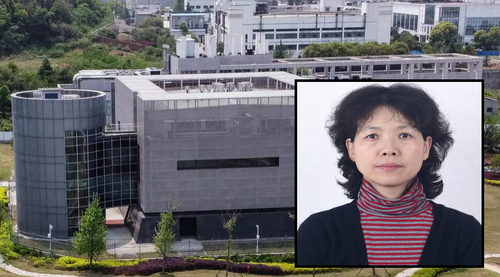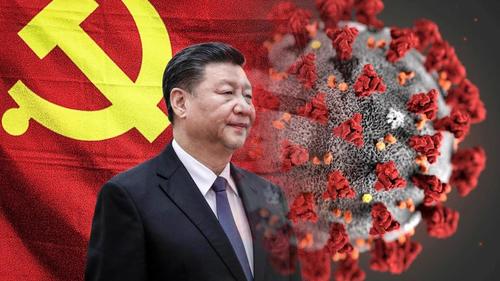China's Clampdown On COVID-19 Origins Exposed As AP Journalists Tailed, Samples Seized
As the World Health Organization and other China puppets struggle to assemble a 'natural origin' theory for COVID-19, the CCP has been going to great lengths to quash non-sanctioned investigations that may instead point to a lab escape from research facilities which made international headlines in 2015 for dangerous 'gain-of-function' research - by which they were manipulating coronaviruses to better infect humans.
 'Batwoman' Shi Zhengli, known for bioengineering bat coronaviruses, was criticized over dangerous 'gain-of-function' experiments
'Batwoman' Shi Zhengli, known for bioengineering bat coronaviruses, was criticized over dangerous 'gain-of-function' experiments
And while mainstream news outlets spent the better part of 2019 flatly rejecting lab-origin evidence as 'debunked conspiracy theories' - which earned ZeroHedge a temporary Twitter ban and a plethora of social media warning labels and 'fact checks' (including one from a former Wuhan Lab worker) the same mainstream outlets are now finding China's suppression of COVID-19 origin theories suspicious.
As part of their investigation, AP interviewed dozens of Chinese and foreign scientists and officials, while also reviewing leaked emails, internal data, as well as documents from China's CDC and cabinet. And what did they find? "A pattern of government secrecy and top-down control that has been evident throughout the pandemic."
...for scientists and journalists, it has become a black hole of no information because of political sensitivity and secrecy.
A bat research team visiting recently managed to take samples but had them confiscated, two people familiar with the matter said. Specialists in coronaviruses have been ordered not to speak to the press. And a team of Associated Press journalists was tailed by plainclothes police in multiple cars who blocked access to roads and sites in late November.
More than a year since the first known person was infected with the coronavirus, an AP investigation shows the Chinese government is strictly controlling all research into its origins, clamping down on some while actively promoting fringe theories that it could have come from outside China. -Associated Press
Let's quickly review the world's easiest game of connect-the-dots:
- In 2013, scientists at the Wuhan Institute of Virology collected horseshoe bat feces at a cave 1,000 miles away infected with a coronavirus 96.2% identical to the virus which causes COVID-19 (Nature).
- Peng Zhou, Wuhan Institute of Virology's head of Bat Virus Infection and Immunization, was researching "the molecular mechanism that allows Ebola and SARS-associated coronaviruses to lie dormant for a long time without causing diseases," while a press release from his lab was titled "How bats carry viruses without getting sick."
- Zhou's colleague, Shi Zhengli, has been involved in bioengineering bat coronaviruses - co-authoring a controversial 2015 paper which described the creation of a new virus by combining a coronavirus found in Chinese horseshoe bats with another that causes human-like severe acute respiratory syndrome (SARS) in mice.
- In 2015, Nature magazine expressed concern over Zhengli's experiments with bat coronavirus. The same year, the US government suspended funding to the lab due to their concern over risks of experimenting with bat coronavirus.
- Meanwhile, the US State Department warned over safety standards at the Wuhan lab in a series of cables beginning in 2015, according to the Washington Post's Josh Rogin.
Add to that China's active suppression of lab-origin theories while their partners at the World Health Organization continue to hunt for some heretofore non-existent crossover species, and it doesn't take Matlock to figure out that the official narrative is severely flawed.
The government is handing out hundreds of thousands of dollars in grants to scientists researching the virus’ origins in southern China and affiliated with the military, the AP has found. But it is monitoring their findings and mandating that the publication of any data or research must be approved by a new task force managed by China’s cabinet, under direct orders from President Xi Jinping, according to internal documents obtained by the AP. A rare leak from within the government, the dozens of pages of unpublished documents confirm what many have long suspected: The clampdown comes from the top.
As a result, very little has been made public. Authorities are severely limiting information and impeding cooperation with international scientists. -Associated Press
"What did they find?" asks Duke University epidemiologist, Gregory Gray, who oversees a lab in China studying the transmission of infectious diseases from animals to people. "Maybe their data were not conclusive, or maybe they suppressed the data for some political reason. I don’t know … I wish I did."
Scientists familiar with China's public health system say the CCP's standard operating procedure of information control and censorship apply to all aspects of COVID-19 research.
"They only select people they can trust, those that they can control," said one public health expert who works regularly with China's CDC. "Military teams and others are working hard on this, but whether it gets published all depends on the outcome."
According to the report, Beijing worries that investigations will also reveal that they were negligent in the spread of the virus.
Some public health experts warn that China’s refusal to grant further access to international scientists has jeopardized the global collaboration that pinpointed the source of the SARS outbreak nearly two decades ago. Jonna Mazet, a founding executive director of the UC Davis One Health Institute, said the lack of collaboration between Chinese and U.S. scientists was “a disappointment” and the inability of American scientists to work in China “devastating.”
“There’s so much speculation around the origins of this virus,” Mazet said. “We need to step back...and let scientists get the real answer without the finger-pointing.” -Associated Press
Steering the narrative
Now that AP has caught up and corroborated what we've been reporting on ad nauseam - albeit via burning their own hand on the stove - they're also piecing together the enormous disinformation campaign employed by Beijing to try and control the narrative.
After the initial batch of COVID-19 cases were traced to the Hunan Seafood market in Wuhan, authorities began collecting samples for analysis - finding that 33 out of 585 environmental samples tested positive for the virus.
"This corona(virus) is very close to SARS," wrote Canadian microbiologist Gary Kobinger, a WHO adviser, according to internal China CDC data obtained by AP. "If we put aside an accident ... then I would look at the bats in these markets (sold and ‘wild’)."
Then, "As the virus continued spreading rapidly into February, Chinese scientists published a burst of research papers on COVID-19. Then a paper by two Chinese scientists proposed without concrete evidence that the virus could have leaked from a Wuhan laboratory near the market. It was later taken down, but it raised the need for image control."
Internal documents show that the state soon began requiring all coronavirus studies in China to be approved by high-level government officials — a policy that critics say paralyzed research efforts.
A China CDC lab notice on Feb. 24 put in new approval processes for publication under “important instructions” from Chinese President Xi Jinping. Other notices ordered CDC staff not to share any data, specimens or other information related to the coronavirus with outside institutions or individuals.
Then on March 2, Xi emphasized “coordination” on coronavirus research, state media reported.
The next day, China’s cabinet, the State Council, centralized all COVID-19 publication under a special task force. The notice, obtained by the AP and marked “not to be made public,” was far more sweeping in scope than the earlier CDC notices, applying to all universities, companies and medical and research institutions.
The order said communication and publication of research had to be orchestrated like “a game of chess” under instructions from Xi, and propaganda and public opinion teams were to “guide publication.” It went on to warn that those who publish without permission, “causing serious adverse social impact, shall be held accountable.” -Associated Press
"The regulations are very strict, and they don’t make any sense," said one former China DCD deputy director on condition of anonymity. "I think it’s political, because people overseas could find things being said there that might contradict what China says, so it’s all being controlled."
And after thousands of samples were taken from the Hunan Seafood market, no findings were ever made public. Yet, on May 25, CDC chief Gao Fu finally broke the silence - telling China's Phoenix TV that no animal samples from the market had tested positive, ruling out the market as the likely source of the virus despite its link to the majority of new cases in the region.
China’s government-controlled media used the theory to suggest the original outbreak in Wuhan could have started with seafood imported from abroad — a notion international scientists reject. WHO has said it is very unlikely that people can be infected with COVID-19 via packaged food, and that it is “highly speculative” to suggest COVID-19 did not start in China. Bi did not respond to requests for an interview, and China has not provided enough virus samples for a definitive analysis.
We would be remiss if we didn't note that the now-destroyed Wet Market was located roughly 900 feet from a China CDC aboratory where they were experimenting on bat coronavirus.
Read the rest of AP's report here.
via IFTTT
InoreaderURL: SECONDARY LINK

